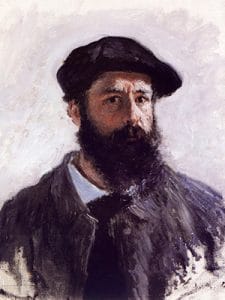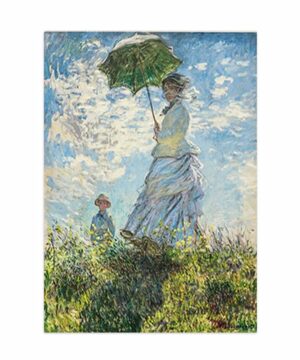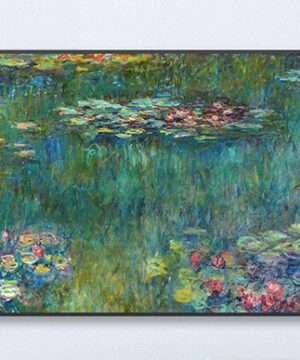Monet

French painter Claude Monet (1840 – 1926) was a key figure of the impressionist movement which started in the second half of the 19th century. During his long career, Monet unswervingly focused on depicting leisure activities and plein air landscape painting. Born in Paris, his family moved to Le Havre in Normandy when Claude was 5 years old. From early on, he was determined to become an artist and was supported by his mother, who was a singer, in this endeavour. He was educated at Le Havre secondary school of the arts and attended drawing lessons.
During a seven-year period of military service in Algeria, he only had little time for painting, but fully dedicated himself to the arts after he became a student of Charles Gleyre in Paris, where he met fellow artists Alfred Sisley and Pierre-Auguste Renoir among others. They shared a new approach to art, promoting depicting the effects of light en pleinair with rapid brush strokes and broken colour. In an independent exhibition with Camille Pissarro, Renoir, and others in 1874, Monet’s painting “Impression, Sunrise” drew scorn for the unfinished appearance of its loose handling and indistinct forms by art critics. However, the artists received the criticism as confirmation and subsequently called themselves “Impressionists”.
Monet committed himself to painting the French countryside and, after having purchased a house in Giverny, painting water lilies – some of his motives, which are most widely known today. He would adopt the mothed of painting the same scene multiple times as to capture light and seasonal changes.
Years after Monet’s death, his home and garden with the waterlily pond were bequeathed to the French Academy of Fine Arts in 1966. Today, Monet is widely considered to have led the way to 20th century modernism by his unique style.
Showing all 3 resultsSorted by popularity
%27%20fill-opacity%3D%27.5%27%3E%3Cellipse%20fill%3D%22%23434922%22%20fill-opacity%3D%22.5%22%20rx%3D%221%22%20ry%3D%221%22%20transform%3D%22matrix(1.75893%20-55.97%2093.1281%202.92667%20147.6%20272.7)%22%2F%3E%3Cellipse%20fill%3D%22%23fff%22%20fill-opacity%3D%22.5%22%20rx%3D%221%22%20ry%3D%221%22%20transform%3D%22rotate(-3.2%203328%20-5340.1)%20scale(57.04474%20298.12498)%22%2F%3E%3Cellipse%20fill%3D%22%23fff%22%20fill-opacity%3D%22.5%22%20rx%3D%221%22%20ry%3D%221%22%20transform%3D%22rotate(1.8%20-3617.4%20842.5)%20scale(31.20206%20298.12499)%22%2F%3E%3Cellipse%20fill%3D%22%237d7c7f%22%20fill-opacity%3D%22.5%22%20rx%3D%221%22%20ry%3D%221%22%20transform%3D%22matrix(65.25629%208.94521%20-5.26886%2038.43691%20144.6%2071.6)%22%2F%3E%3C%2Fg%3E%3C%2Fsvg%3E)
Woman with a Parasol – Madame Monet and Her Son by Claude Monet – Canvas Giclée Print
$99.00 – $175.00Select options This product has multiple variants. The options may be chosen on the product page%22%20transform%3D%22translate(.7%20.7)%20scale(1.40625)%22%20fill-opacity%3D%22.5%22%3E%3Cellipse%20fill%3D%22%23838f8e%22%20rx%3D%221%22%20ry%3D%221%22%20transform%3D%22rotate(-3.1%202131.6%20-1582)%20scale(143.50215%2065.73003)%22%2F%3E%3Cellipse%20fill%3D%22%23d6d2dd%22%20rx%3D%221%22%20ry%3D%221%22%20transform%3D%22matrix(1.42952%20-30.42933%20211.76645%209.94841%2087.6%20236.4)%22%2F%3E%3Cpath%20fill%3D%22%23dfdddb%22%20d%3D%22M214%2025.5L2.6%2040.3-2-25.5l211.4-14.8z%22%2F%3E%3Cellipse%20fill%3D%22%23dec862%22%20cx%3D%22149%22%20cy%3D%2242%22%20rx%3D%2265%22%20ry%3D%2220%22%2F%3E%3C%2Fg%3E%3C%2Fsvg%3E)
Impression, Sunrise by Claude Monet – Canvas Giclée Print
$99.00 – $179.00Select options This product has multiple variants. The options may be chosen on the product page%22%20transform%3D%22translate(.7%20.7)%20scale(1.40625)%22%20fill-opacity%3D%22.5%22%3E%3Cellipse%20fill%3D%22%23fff%22%20rx%3D%221%22%20ry%3D%221%22%20transform%3D%22matrix(.06942%2024.69137%20-202.90629%20.57047%20114.8%206.8)%22%2F%3E%3Cellipse%20fill%3D%22%2310543d%22%20rx%3D%221%22%20ry%3D%221%22%20transform%3D%22matrix(168.14294%20-17.9693%206.24896%2058.47297%2099.8%20113)%22%2F%3E%3Cellipse%20fill%3D%22%23f6e2e9%22%20rx%3D%221%22%20ry%3D%221%22%20transform%3D%22rotate(.6%20-23328.6%2010133.9)%20scale(195.92626%2035.67971)%22%2F%3E%3Cellipse%20fill%3D%22%23fff9fc%22%20cx%3D%2267%22%20rx%3D%22200%22%20ry%3D%2217%22%2F%3E%3C%2Fg%3E%3C%2Fsvg%3E)
Water Lilies – Green Reflections by Claude Monet – Canvas Giclée Print
$189.00 – $259.00Select options This product has multiple variants. The options may be chosen on the product page



